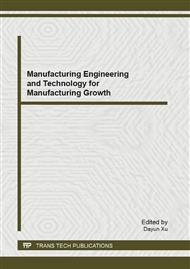[1]
R. Buyya, M. Parashar, User requirements for cloud computing architecture, Proc. 10th IEEE/ACM, International conference on cluster, Cloud and grid computing, (2010) 625-630.
DOI: 10.1109/ccgrid.2010.20
Google Scholar
[2]
S.N. Ahmed, Reaching for the cloud: How SMEs can manage. International Journal of Information Management, 31 (2011) 272-278.
DOI: 10.1016/j.ijinfomgt.2010.08.001
Google Scholar
[3]
R. Chow, P. Golle & M. Jakobsson, Controlling data in the cloud: Outsourcing computation without outsourcing control. Fujitsu Laboratories of America, Chicago: Illionois. (2009).
DOI: 10.1145/1655008.1655020
Google Scholar
[4]
G.E. Rejda,. Principles of risk management & insurance. 11th Edition. New Jersey: Prentice Hall, (2011).
Google Scholar
[5]
K. Awati, Cox's risk matrix theorem and its implications for project risk management. Available at: http: /eight2late. wordpress. com/2009/07/01/cox%E2%80%99s-risk-matrix-theorem-and-its-implications-for-project-risk-management/, (2009).
Google Scholar
[6]
L.A. Cox, What's wrong with risk Matrices? Risk analysis, 28(2) (2008). 497-515.
Google Scholar
[7]
S.H. Lim, Risks in the North Korean special economic zone: Context, identification, & assessment. Emerging markets finance & trade, 47(1) (2011) 50-66.
DOI: 10.2753/ree1540-496x470103
Google Scholar
[8]
F. Picado, G. Barmen, G. Bengtsson, S. Cuadra, K. Jakobsson & A. Mendoza, Ecological, groundwater, and human health risk assessment in a mining region of Nicaragua, Risk analysis: An international journal, 30(6) (2010) 916-33.
DOI: 10.1111/j.1539-6924.2010.01387.x
Google Scholar
[9]
K.D.M. Pintar, D.F. Charron, A. Fazil S.A. McEwen, F. Pollari & D. Waltner-Toews, A risk assessment model to evaluate the role of fecal contamination in recreational water on the incidence of cryptosporidiosis at the community level in Ontario, Risk analysis: An international journal, 30(1) (2010).
DOI: 10.1111/j.1539-6924.2009.01321.x
Google Scholar
[10]
T. Aven, O. Renn, The role of quantitative risk assessments for characterizing risk & uncertainty & delineating appropriate risk management options, with special emphasis on terrorism risk, Risk analysis: An international journal, 29(4) (2009).
DOI: 10.1111/j.1539-6924.2008.01175.x
Google Scholar
[11]
S. Subashini, V. Kavitha, A survey on security issues in service delivery models of cloud computing. J. of Network & computer applications, 34 (2011) 1-11.
DOI: 10.1016/j.jnca.2010.07.006
Google Scholar
[12]
J. Casale, Social networking, cloud computing bring new risk exposures. Business insurance, 44(38) (2010) 17.
Google Scholar
[13]
E. Bublitz, Catching the cloud: managing risk when utilizing cloud computing, National underwriter property & casualty, (2010) p.12, 13, 16.
Google Scholar
[14]
S. Paquette, P.T. Jaeger & S.C. Wilson, Identifying the security risks associated with governmental use of cloud computing, Government information quarterly, 27 (2010) 245-53.
DOI: 10.1016/j.giq.2010.01.002
Google Scholar
[15]
P.T. Jaeger, J.M. Grimes, J. Lin & S.N. Simmons, Where is the cloud? geography, economics, environment, & jurisdiction in cloud computing, 14(5) (2009) 4-15.
DOI: 10.5210/fm.v14i5.2456
Google Scholar
[16]
D. Svantesson, R. Clarke, Privacy and consumer risks in cloud computing. Computer law & security review, 26 (2010) 391-397.
DOI: 10.1016/j.clsr.2010.05.005
Google Scholar
[17]
M. Armburst, A. Fox, R. Griffith, A. D. Joseph, R. Katz & A. Konwinski, Above the clouds: a Berkley view of cloud computing. Available at: http: /radlab. cs. berkekey. edu/, (2009).
Google Scholar
[18]
T.L. Saaty, The analytic hierarchy process. McGraw Hill Publications, (1980).
Google Scholar
[19]
T.L. Saaty, How to make a decision: The analytic hierarchy process, European journal of operational research, 48(1) (1990) 9-26.
DOI: 10.1016/0377-2217(90)90057-i
Google Scholar


